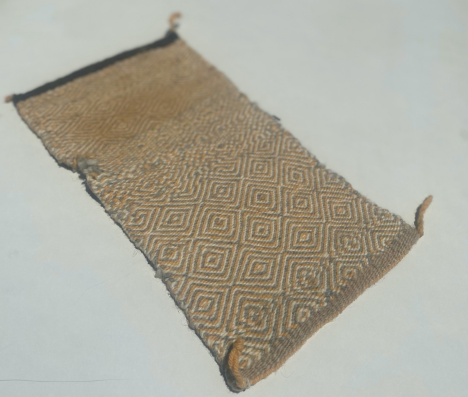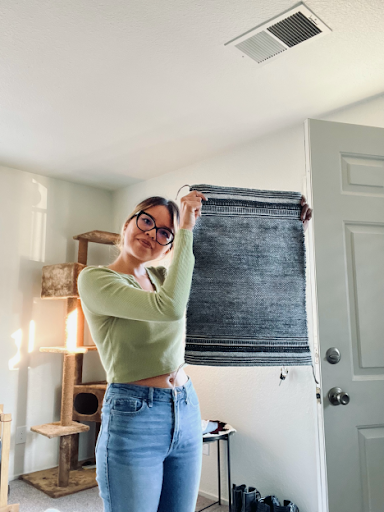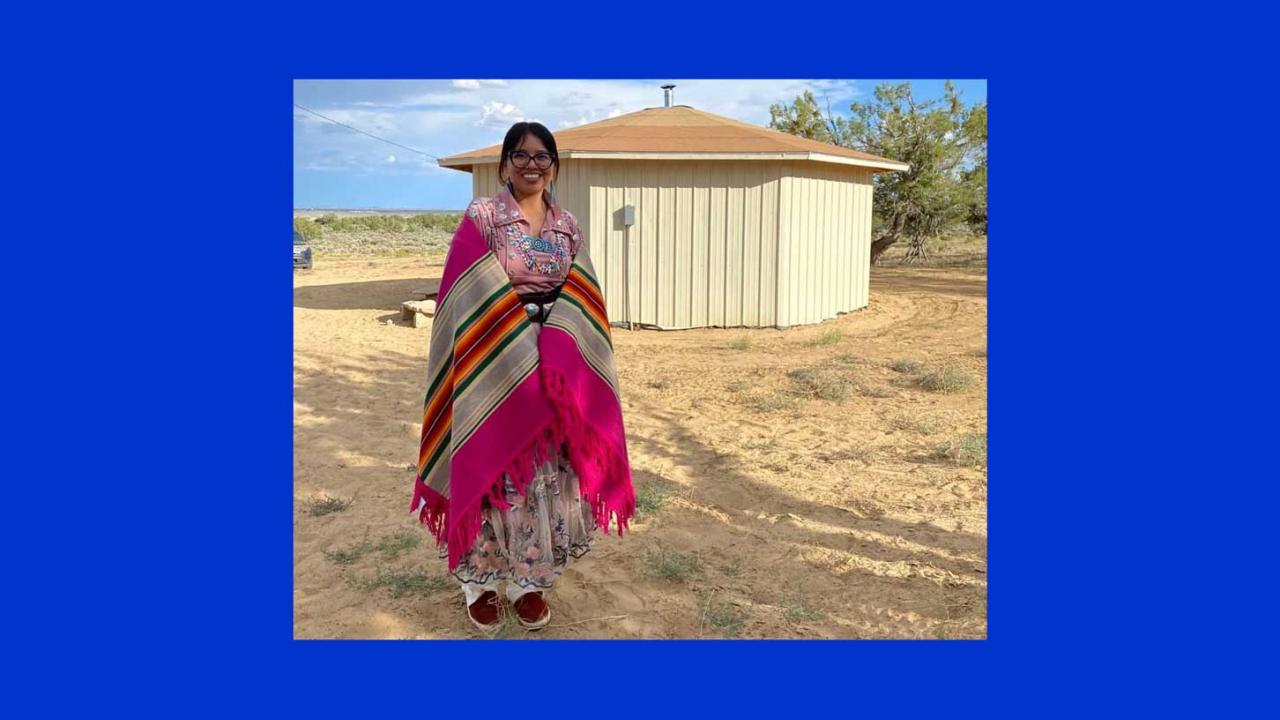In a Western world that suppresses Indigenous culture, members of the Navajo Nation actively engage in artistic cultural revival as a means to keep their history alive and to create vibrant futures. During a fellowship, Shawna Yazzie, a P.h.D. student in Native American studies at the University of California, Davis, has been looking at and learning the ongoing rug weaving practices at a Body of Water in a Sunken Area, also known as Piñon, Arizona, her family’s homeland.
She writes of her family, below, in Diné and English:
Ya’atééh shik’éi dóó shi’Diné’é. Totsohníí nishtłı̨́. Tłaaschíí’í bashishchíín. Kinyáá’aanii ei dashicheíí. Tanéézahnı̨́ı̨́ei dashínalí. Ákót’éego Diné asdzáá nishłı̨́. Beʼekʼid Baa Ahoodzánídéé naashá. Shí ei Shawna Yazzie yíníshye. Shimá éi Bernita Edgewater wolyé áádóó shizhé’é éi Michael B. Yazzie Sr. wolyé. Shimá éi Jádítódí naaghá áádóó shizhé’é ei Beʼekʼid Baa Ahoodzánídi naaghá. Shimá sání éi Lena James wolyé ntéé áádóó shicheii éi Howard James wolyé ntéé. Jádítódiéé naa’ash ntéé. Shinálí asdzą́ą́ éi Helen Mae Yazzie wolyé áádóó shinálí hastiin éi Kee Bahe Yazzie Sr. wolyé ntéé. Beʼekʼid Baa Ahoodzánídéé naa’ash.
Hello to my family, friends, and people. I am of the Big Water. I am born for the Red Bottom People. My maternal grandfathers are the Towering House. My paternal grandfathers are the Tangle Peoples.
I am a Diné woman. I am from A Body of Water in a Sunken Area. My name is Shawna Rae Yazzie. My mother is Bernita Edgewater and my father is Michael B. Yazzie Sr. My mother is from Jeddito, Arizona. My father is from Piñon, Arizona. My maternal grandmother was Lena James and maternal grandfather was Howard James, who were from Jeddito, Arizona. My paternal grandma is Helen Mae Yazzie and my paternal grandfather was Kee Bahe Yazzie Sr., who are from Piñon, Arizona.
Yazzie is spending time in her native homeland of Piñon after being selected for a 2022 Cobell Graduate Summer Research Fellowship. She is one of five fellows from a highly competitive pool of over 100 graduate applicants who were selected for the Sixth Summer Research Fellowship cohort, each receiving $5,000.
Her research project titled, “Tł’ááschí’í Da’atłʼóh: Diné Weaving Stories of Survivance through the Warp of a Fingers of Red Bottom Girl,” amplifies Diné ways of illustrating history — privileging Diné knowledges and practices — as a means to Indigenize academic theories, methods and practices. Her project shares how Diné women in Piñon, Arizona, build a long-lasting connection to rug weaving.
Weaving as healing
She comes by this heritage, and yearning for healing, quite naturally.
“A few months ago, I sat at my grandmother’s kitchen table on an early Saturday morning. We discussed the practice of rug weaving and how she wove beautiful rugs years ago. With an ache in her heart, she expressed in Diné Bizaad (Diné language), ‘I once had an auntie who gave birth to a son. Unfortunately, my auntie died in childbirth, but her newborn baby was taken by the missionaries.’”

“While I cannot understand what she felt, I understood that healing needed to take place,” Yazzie said. “By referencing the violence, my grandmother declared a history of colonial disruptions and acknowledged the survivance of Diné, a reason why she does not weave anymore. I declare and call on a (re)awakening and art resurgence of rug weaving into existence to bring healing.”
Rug weaving as shared with me is a breathing life form, it has a life of its own in which I (as a weaver) embark on creating healing for a vibrant future.” — Yazzie
Through community-based, Native feminism-centered research, her work seeks to understand how Diné women continue to reclaim and heal their identities through rug weaving, she said.
“This is the type of healing that has led me to successfully reshare and remember this practice with other community members across the Navajo Nation.”
Diné women from what is currently known as Piñon, Arizona, practice the creative art of Da’atłʼóh (rug weaving). Today, the Tł’ááschí’í (Red Bottom Clan) continue to weave despite having endured many colonial disruptions.
In the 1860s, Diné were forcibly removed from their homelands and imprisoned at Bosque Redondo in Fort Sumner, New Mexico. This period ended with the signing of the Treaty of 1868, which has subsequently left an indelible mark on the transfer of cultural knowledge.
“As a community member, I have played a role in the ongoing survivance of rug weaving practices primarily through (re)learning the teachings and lessons from family and community members,” said Yazzie.
Reawakening wellness

Yazzie seeks to remember the history and protocols of Diné creative arts by reawakening women’s rug weaving practices in Piñon and restoring the community’s health and wellness. Her research uplifts the significance of Diné creative arts outside of settler capitalist frameworks and argues that weaving acts as an extension of Diné philosophical and intellectual traditions that teaches humans one’s existence in the universe and how to live a life in peace and harmony.
After completing her doctoral coursework and qualifying exams, Yazzie relocated to Piñon for the entirety of summer 2022. The primary goal for this phase was completing, submitting, and gaining approval for her research protocols from the Navajo Nation Human Research Review Board and the UC Davis Institutional Review Board.
Yazzie’s summer project focused on learning from master weavers in her home community to document how their practices embody Diné history. “I began the process of engaging with community grandmothers through listening, talking, and remembering what it is that they are willing to do and share. By fall 2022, I will be ready to present and submit a final report that includes reflections and assurances with, by, and for the community.”
Yazzie’s research during the summer also included herding sheep, yard cleaning and tending to other livestock, as well as rug weaving. She explained that relationship.
“Sheep are a pivotal part of the research process that allow for storytelling to happen,” she said. “Stories invoke relationships to be strongly grounded as it is an Indigenous feminist practice,” she continued.
“Rug weaving as shared with me is a breathing life form, it has a life of its own in which I (as a weaver) embark on creating healing for a vibrant future.” Yazzie describes this collective healing as survivance, explaining that it creates an act of Native presence.
“For instance,” she explained, “the process of the sheep shearing actively involves one’s relation to our more than human relatives (sheep) in relation to the land (A Body of Water in a Sunken Area).”
Resurgence
“My scholarship is committed to working with, by and for my Diné community to extend the act of K’e [Diné Kinship Systems] to right the wrongs of previous research and increase the dialogue across the Navajo Nation,” Yazzie said. “My research seeks to uplift and support an emerging creative arts resurgence movement and the reintroduction of rug weaving across the Red Bottom Clan for present and future generations.”
This is a story about how she came to understand herself as a Diné, she said.
“My intention is not to speak on behalf of the Navajo Nation, nor do I dismiss the other countless experiences of Diné relatives who live across the Navajo Nation, but to reimagine or rethink and imagine possibilities grounded in the land, family, stories, and embodied knowledge rich with multisensorial archive.”
Yazzie has also been resharing the practice of rug weaving with other community members across the Navajo Nation.
“This initially started out as a place to learn the art of rug weaving. However, this is slowly becoming a part of me and who I am becoming as it is a lifelong journey.”
Media Resources
Media Contact:
- Karen Nikos-Rose, kmnikos@ucdavis.edu, 530-219-5472
